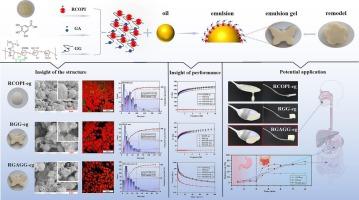Gallic acid-reinforced Rana chensinensis ovum protein isolates-Gellan gum thermally reversible emulsion gel: Insight of the structure and potential applications in dysphagia management
IF 8
1区 农林科学
Q1 FOOD SCIENCE & TECHNOLOGY
引用次数: 0
Abstract
This study investigated the impacts of gallic acid (GA) on the structural and functional properties of Rana chensinensis ovum protein isolate (RCOPI)-gellan gum (GG) Pickering emulsion gels. An innovative Pickering emulsion gel system (RGAGG-eg) was successfully developed. Mechanistic studies revealed that GA may act as a molecular bridge, utilizing its own phenolic hydroxyl and carboxyl groups to enhance the interaction of RCOPI-GG through hydrogen bonding. This resulted in a 21.23 % reduction in the particle size of the RGAGG-cx, indicating that a denser crosslinked network was obtained. The particle size of the RGAGG-em droplets is reduced by 32.39 % as a result of the more closely bound complex particles being more securely adsorbed on the surface of the oil droplets. The helical change of the GG structure caused the emulsion to gel during the heating phase. CLSM and SEM confirmed GA-induced microstructural compaction, while rheological analysis demonstrated improved gel strength (G' > G''). The RGAGG-eg met IDDSI levels 4 pureed properties ideal for dysphagia management. As a proof-of-concept, the system achieved 98.26 % β-carotene encapsulation efficiency with 69.81 % bioaccessibility. Those results suggested the RGAGG-eg demonstrated dual functionality as a nutrient carrier and texture-modified food.

没食子酸增强的中国林蛙卵分离蛋白-结冷胶热可逆乳凝胶:结构及其在吞咽困难治疗中的潜在应用
本研究研究了没食子酸(GA)对中国林蛙卵分离蛋白(RCOPI)-结冷胶(GG) Pickering乳状凝胶结构和功能特性的影响。成功开发了一种创新的皮克林乳液凝胶体系(RGAGG-eg)。机理研究表明,GA可能作为分子桥梁,利用其自身的酚羟基和羧基通过氢键增强RCOPI-GG的相互作用。这导致RGAGG-cx的粒径减小了21.23%,表明得到了更致密的交联网络。由于结合更紧密的复合颗粒在油滴表面的吸附更安全,RGAGG-em液滴的粒径减小了32.39%。GG结构的螺旋变化导致乳状液在加热阶段形成凝胶。CLSM和SEM证实了ga诱导的微观结构压实,而流变学分析表明凝胶强度(G' >; G')有所提高。RGAGG-eg符合IDDSI 4级纯化特性,是治疗吞咽困难的理想选择。作为概念验证,该系统实现了98.26%的β-胡萝卜素包封效率和69.81%的生物可及性。这些结果表明RGAGG-eg具有营养载体和质地改性食品的双重功能。
本文章由计算机程序翻译,如有差异,请以英文原文为准。
求助全文
约1分钟内获得全文
求助全文
来源期刊

Food Research International
工程技术-食品科技
CiteScore
12.50
自引率
7.40%
发文量
1183
审稿时长
79 days
期刊介绍:
Food Research International serves as a rapid dissemination platform for significant and impactful research in food science, technology, engineering, and nutrition. The journal focuses on publishing novel, high-quality, and high-impact review papers, original research papers, and letters to the editors across various disciplines in the science and technology of food. Additionally, it follows a policy of publishing special issues on topical and emergent subjects in food research or related areas. Selected, peer-reviewed papers from scientific meetings, workshops, and conferences on the science, technology, and engineering of foods are also featured in special issues.
 求助内容:
求助内容: 应助结果提醒方式:
应助结果提醒方式:


